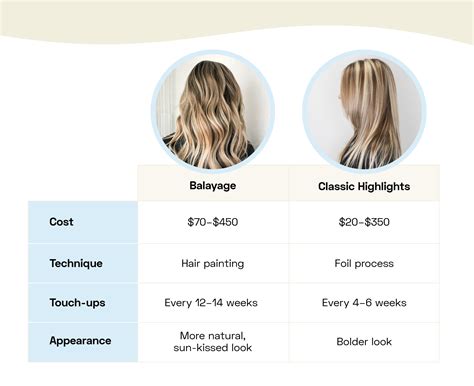Unveiling the Differences in 10 Key Aspects
When it comes to elevating your hair game, highlights and balayage emerge as two captivating techniques. While both strive to illuminate and enhance your locks, their distinct approaches and results set them apart. Let’s delve into the comprehensive differences between these hair-transforming methods:

1. Application Technique
- Highlights: Involves sectioning hair into thin strands and applying lightener directly to them, creating contrasting highlights against your natural color.
- Balayage: Employs a freehand brushing motion to paint on lightener, resulting in seamless, blended highlights that mimic natural sun-kissed effects.
2. Placement
- Highlights: Typically placed in specific sections or patterns, such as around the face or throughout the entire head.
- Balayage: Characterized by a more subtle, scattered distribution of highlights, often concentrated at the mid-lengths to ends.
3. Size and Shape
- Highlights: Smaller and more precise, with a defined, foil-wrapped sectioning.
- Balayage: Larger and blended, with a feathered or blurred appearance.
4. Root Coverage
- Highlights: May require frequent touch-ups at the roots to maintain contrast.
- Balayage: Naturally blends into new growth, minimizing the need for frequent root maintenance.
5. Maintenance
- Highlights: Higher maintenance due to the need for regular root touch-ups.
- Balayage: Lower maintenance as the blended highlights gradually fade and grow out seamlessly.
6. Damage
- Highlights: Can cause more damage to hair due to the use of foil and concentrated lightener.
- Balayage: Generally less damaging as lightener is applied in a more diffused manner.
7. Versatility
- Highlights: Offers a wide range of customization options in terms of placement, size, and color.
- Balayage: Ideal for creating natural-looking, dimensional effects.
8. Cost
- Highlights: Typically more expensive due to the more labor-intensive application process.
- Balayage: Can be more cost-effective as it requires less frequent maintenance.
9. Duration
- Highlights: Last for 3-6 months, depending on hair growth and maintenance.
- Balayage: Can last up to 6 months or longer, with gradual fading as new growth emerges.
10. Ideal for
- Highlights: Suited for those seeking bold, contrasting highlights with a defined look.
- Balayage: Best for individuals desiring a natural, sun-kissed effect with minimal maintenance.
Tables for Comparison
| Feature | Highlights | Balayage |
|---|---|---|
| Application Technique | Foil-wrapped sectioning | Freehand brushing |
| Placement | Specific sections | Scattered distribution |
| Size and Shape | Smaller, precise | Larger, blended |
| Root Coverage | Requires touch-ups | Naturally blends into new growth |
| Maintenance | Higher maintenance | Lower maintenance |
| Damage | More damaging | Less damaging |
| Versatility | Wide range of options | Natural-looking effects |
| Cost | More expensive | More cost-effective |
| Duration | 3-6 months | Up to 6 months or longer |
| Ideal for | Bold, contrasting highlights | Natural, sun-kissed effect |
Effective Strategies for Optimal Results
To achieve the best results with either highlights or balayage, consider these tips:
- Consult a Professional: Seek professional advice from a skilled hairstylist to determine the technique and color that best suits your hair type and desired look.
- Quality Products: Invest in high-quality hair care products specifically designed for color-treated hair to maintain vibrancy and minimize damage.
- Regular Maintenance: Follow your stylist’s recommended maintenance schedule for touch-ups or toning treatments to keep your color fresh.
- Protective Styling: Utilize heat protectants before styling and avoid excessive heat styling to preserve the integrity of your colored hair.
- Deep Conditioning: Regularly deep condition your hair to restore moisture and combat the dryness that can accompany color treatments.
Common Mistakes to Avoid
To prevent common pitfalls, avoid these mistakes:
- Over-Processing: Avoid over-lightening your hair, as this can lead to breakage, damage, and a brassy tone.
- DIY Mishaps: Attempting to DIY highlights or balayage at home can result in uneven application, discoloration, and damage.
- Ignoring Maintenance: Neglecting to maintain your color by skipping touch-ups or toning treatments can lead to fading, brassiness, and dryness.
- Using Harsh Chemicals: Avoid using harsh chemicals or low-quality products, as these can damage your hair and compromise the color.
- Excessive Heat Styling: Overusing heat styling tools without heat protectants can further damage color-treated hair and lead to breakage.
